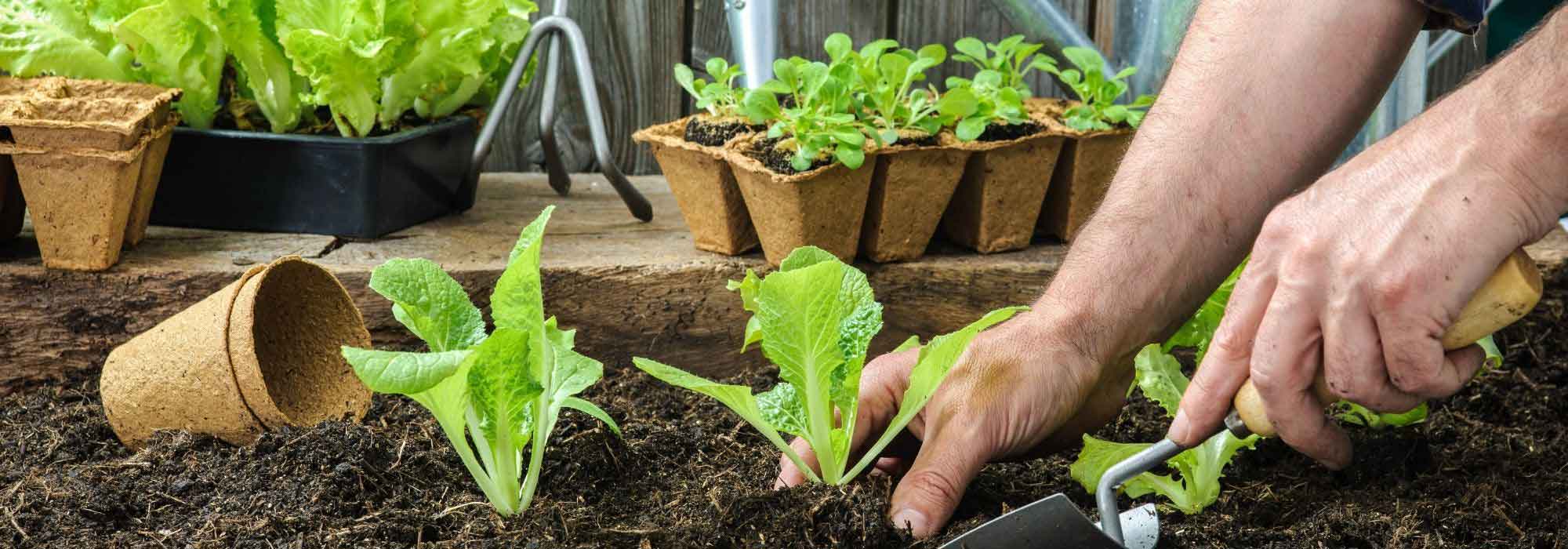
What to do in the garden in April?
Plant now the flowers and vegetables for your summer.
Contents
Gardeners love April, but they also always dread it a little, as until it’s over, this capricious month can bring both the best and the worst! The air is mild, the sun is more generous, and the still damp soil is warming up. Plant fairs are on the horizon everywhere, and new plantings are just waiting for you… April is the perfect month to envision new scenes for the garden or stunning floral displays for the terrace and balcony. In short, we’re looking forward to the beautiful season!
However, not all gardeners are in the same boat… While some are picking their first flowers and harvesting their early vegetables, others are still shivering and must wait for their garden to finally warm up before sowing and transplanting. Whether it’s an ornamental garden or a vegetable patch, do you want to know what to do in the garden in April? Follow our tips!
On the side of trees, bushes, fruit trees, and bamboos
In April, repair frost damage and protect your plants from any late frosts that may still occur. Keep an eye on the weather and have your winter covers ready to put on in the evening and remove during the day. If some of your plants have suffered frost damage, wait a few days for new growth to emerge. Remove the burnt parts down to the green, and new shoots will soon follow. Winter drought affects many regions: remember to water your young plants regularly with generous, well-spaced watering to encourage deep rooting.
Ornamental Trees and Conifers
- Continue planting trees and conifers in containers, ensuring they are properly staked.
- Complete the maintenance pruning of trees started in March.
- Prune spring-flowering trees that have finished blooming, such as mimosas.
Fruit Trees and Berries
Even though they are still just promises of harvests, the sight of flowering fruit trees in April is worth seeing!
- Continue planting fruit trees and berries and enjoy the flowering of fruit trees that attract pollinating insects.
- During this period, spread compost at the base of trees and shrubs for a beneficial organic matter boost. Do not pile it against the trunks, as the buried bark may rot. It is the rootlets at the tips of the roots that absorb nutrients, so spread the compost around the perimeter of the branches.
- Consider growing green manures at the base of fruit trees: they will provide nutrients to the soil (especially nitrogen) and limit the appearance of adventive plants. Weed a circle 1 to 2 m in diameter around your fruit trees and sow 1 or 2 handfuls of phacelia, mustard, field beans, and/or clover. Bury the seeds by raking and water. You will mow in May-June before they flower and leave them in place to decompose, forming a mulch for summer.
- Stake the shoots of trained fruit trees as they grow.
Shrubs
- You can continue planting shrubs in containers. Consider melliferous and nectariferous shrubs to make your garden a true haven for biodiversity!
- Enjoy the flowering of Coronillas, Cytises, Ceanothus, Lilacs, and Rhododendrons.
- After their flowering, complete the pruning of early-flowering shrubs, such as the “Winter Honeysuckle” Lonicera fragrantissima and Lonicera purpusii.
- Prune evergreen shrubs forming small hedges, such as Lonicera nitida and boxwood borders, which will start to grow in all directions as the nice weather arrives. This pruning helps to give them a uniform shape and refresh them using a well-sharpened shear. Feel free to use a string line for guidance.
- Take cuttings of Willow and Forsythia.
Hedges
- Continue planting hedge shrubs in containers. Encourage a mix of species and choose plants suited to the local climate.
- Install windbreak hedges, which remain the best way to protect yourself from prevailing winds.
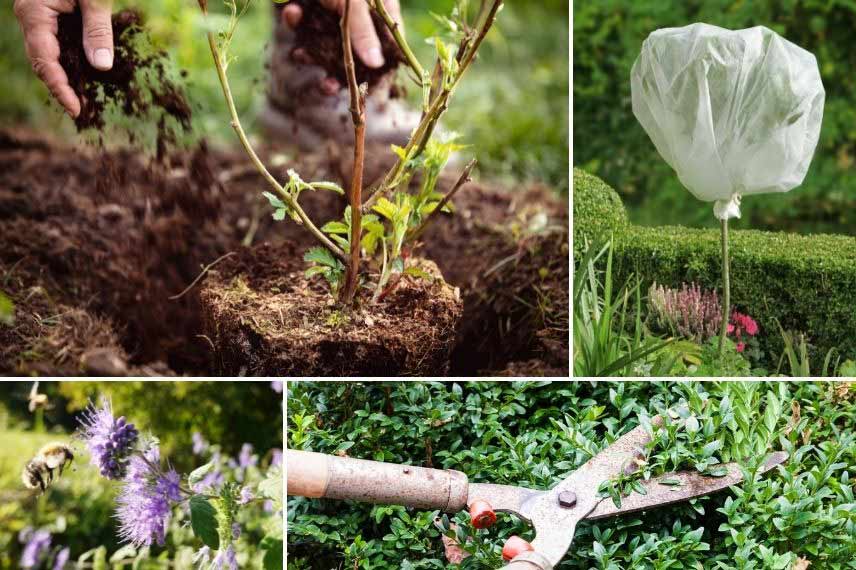 Planting container subjects and pruning are on the agenda in April. Don’t forget to protect your most fragile plants from frost that may still occur and promote biodiversity with melliferous trees and shrubs.
Planting container subjects and pruning are on the agenda in April. Don’t forget to protect your most fragile plants from frost that may still occur and promote biodiversity with melliferous trees and shrubs.
→ Also read Sophie’s good advice in What to plant in spring?
Bamboos
- Remove excess bamboo shoots by cutting them a few centimetres below the ground. Take the opportunity to remove old dry stems, which can be used as stakes.
- Add rich compost or a special bamboo fertiliser high in nitrogen.
→ To learn everything about bamboos and their care, check out our article BAMBOOS: PLANTING, PRUNING, MAINTAINING
Perennials, grasses, bulbs and climbing plants
Perennials
- To enjoy the bells of lily of the valley from the beginning of May, you can force them a bit. For this, place a salad cloche, a mini-greenhouse, or a small frame over the plants. Remember to ventilate often during the day to avoid any risk of rot.
- Finish planting perennials in containers and dividing the most vigorous clumps. Be sure to water beforehand and separate the offsets with a sharp spade. Taken with a sufficient root ball, these new plants can be replanted directly. The smaller ones or those lacking roots will need to be nurtured in pots before being transplanted in autumn.
- As soon as the first sunny days arrive, the growth of perennials starts rapidly. Take the opportunity to place stakes and supports for the taller ones. You just need to tie them with one or two discreet turns of string as the stems grow.
- Collect and transplant young seedlings from spontaneous sowings of perennials: Gauras, Valerians, Euphorbias, Alliums… will happily fill the empty spaces in your flower beds.
- Pinch the santolines and the Cinerarias to thicken them.
- Take cuttings of sage, ornamental sages, and lavender.
- Take cuttings of Sedums, Kalanchoes, and Crassulas using leaf cuttings.
Grasses
- Finish pruning and dividing grasses and proceed with their cleaning.
Bulbs
- It’s the crossover of spring bulbs and summer bulbs: some are flowering while others need to be planted this April. Simply cut the flowers of the spring bulbs when they have faded (Daffodils, etc.) while allowing their foliage to dry.
- The summer bulbs, such as Lilies, Alstroemerias, Arums, Tulbaghias, Begonias, Gladioli, or Crocosmias can be planted when temperatures exceed 10°C. Work and aerate the soil well beforehand. Plant them in groups and complement with a sowing of annuals on top: Nigellas, Hybrid Verbenas, or Cosmos will enhance the flowering and hide the sometimes unsightly base of the bulbs. Remember to mark their location.
- Dahlias are planted at the same time as potatoes, when lilacs are in bloom… or when you hear the cuckoo sing. Unless it’s the other way around? Anyway, one thing is certain, you can plant the tubers before they start to grow, remembering to place a small stake with a label indicating the variety. You can also start dahlias indoors, placing them in trays in a warm, bright room. Then plant them in the garden with their first green shoots.
→ To grow them like an expert, check out our article DAHLIA: PLANTING, MAINTENANCE AND GROWING TIPS
Climbers
- Continue planting climbers in containers and attaching them to their supports as the shoots grow.
- Prune the Solanum jasminoides
- Prune the vine in green, leaving only 2 buds on each stem.
- Take cuttings of ivy.
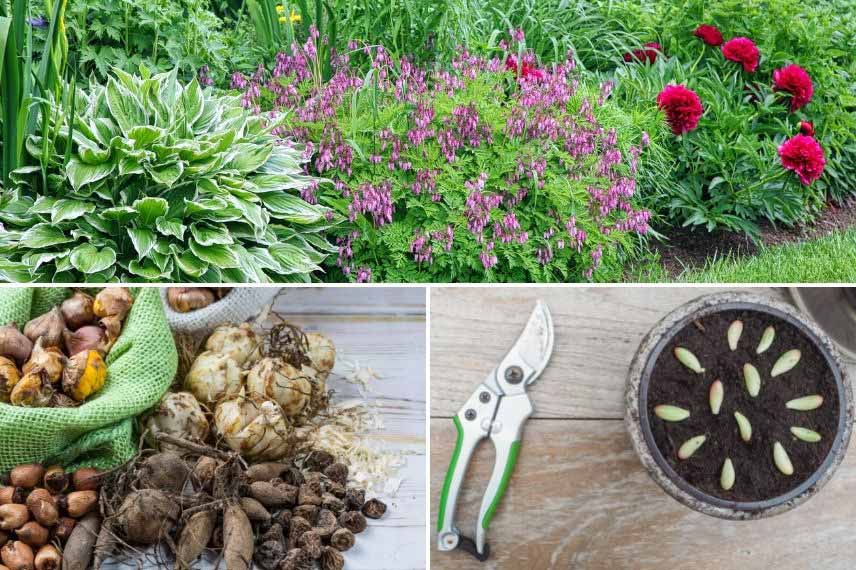
Setting up perennials and summer bulbs, leaf cuttings… there are plenty of activities this April
Roses
- Complete the planting of roses in containers.
- If not already done in the colder regions, prune the repeat flowering roses, whether bush or climbing, and spread a special organic fertiliser for roses by scratching.
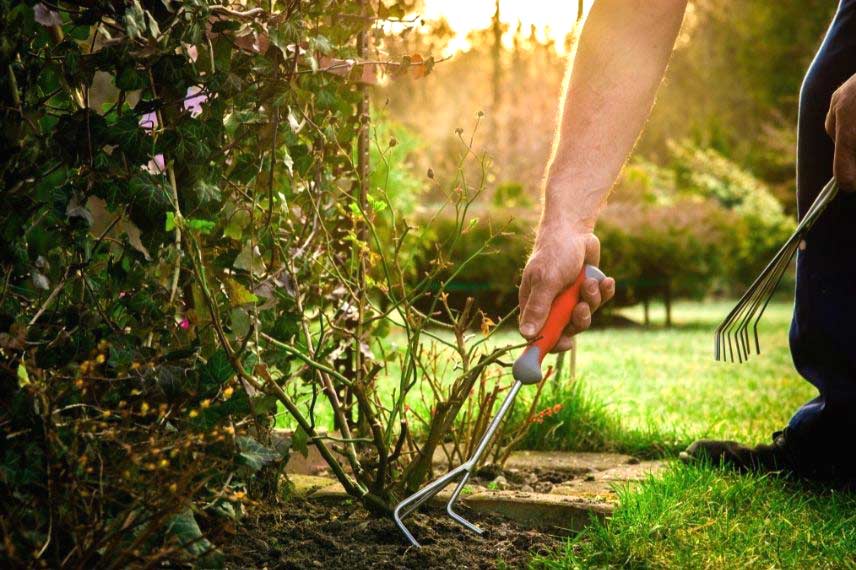
Spreading a specific fertiliser will ensure a magnificent flowering for your roses
- Mulch the base of your roses with organic mulch made from homemade chippings, miscanthus mulch or hemp.
- Watch for the appearance of suckers at the base of grafted roses. These young shoots weaken the bush, as the rootstock regains vigour by diverting the sap for its own benefit. This sucker is easily recognised as it usually has 7 leaflets instead of 5, and the thorns of the wildlings are generally smaller and closer together. Clear a bit of soil at the base of the rose and cut this sucker at its base with a clean cut using a sharp tool.
- Train the sarmentous roses as they grow, as horizontally as possible.
Annuals and potted plants
Annuals
- Care for young plants from sowing or plug plants in a sheltered spot: your small pots of Pelargoniums, Impatiens, Sweet peas, Delphiniums, or Clarkias can be placed in the sun during the day, but remember to bring them in at night. A frost, even a light one, could be fatal to these tender plants.
- Prepare the flower beds and borders intended for summer annuals.
- Thoroughly clean your pots and containers with warm water and vinegar before planting new plants.
- Repot the annuals sown in February-March to create your pots, hanging baskets, and containers. Combine them by mixing colours and considering their needs in terms of exposure and watering, and don’t forget drainage. Keep your displays sheltered according to the weather.
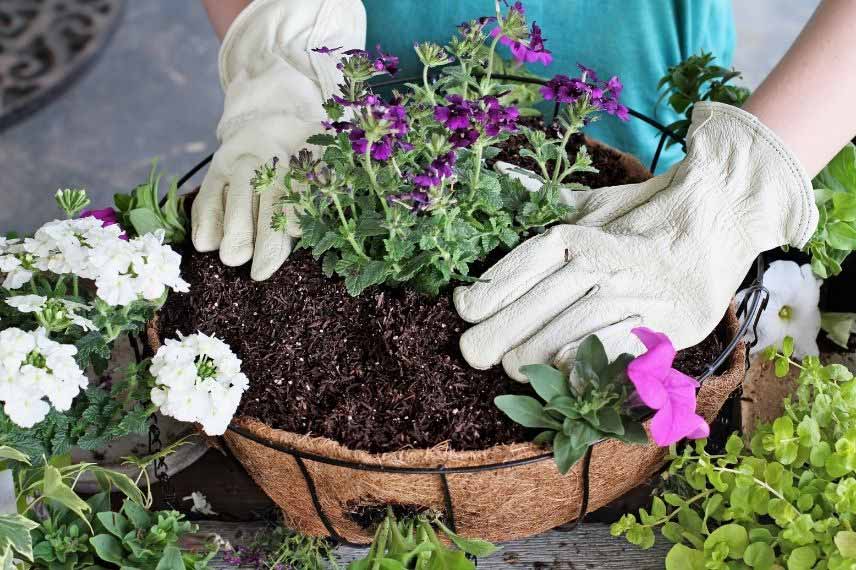 Repot your young plants into your hanging baskets, pots, and containers[/caption>
Repot your young plants into your hanging baskets, pots, and containers[/caption>
→ Follow our expert advice to learn how to plant window boxes and hanging baskets with annuals in plug plants
Potted Plants
- Repot plants that need it into larger pots, using suitable potting soil. Also consider houseplants and take the opportunity to give them a much-needed dusting.
In the vegetable garden
What a pleasure to crunch the first radishes of the year! It’s also the time to sow green manures such as mustard in a free plot of the vegetable garden. It will be mown two months later, before being buried.
Planting and tasks to do
- Continue the first plantings in the vegetable garden such as garlic, shallots, white onions, celery roots, celery stalks, and strawberries.
- Plant herbs. Too much moisture or too much shade reduces their fragrance: grow them in the sun, in well-drained, rich soil. Remember that chives will need soil that is not too dry and watering throughout the beautiful season. Place Chamomile plants next to those susceptible to aphid attacks.
- Plant sprouted potatoes with the sprouts facing up, at a depth of 15 cm. You can also try the amazing method of growing potatoes on grass!
- Continue to ventilate the frames and tunnels during the day in mild weather.
- Remember to protect young plants, especially tender little salads, from the voracity of slugs: a cord of a few centimetres of wood ash around them makes a good barrier against these molluscs.
- Organise your strawberries, transplant spontaneous plants in rows, clean up dead leaves, weed, and hoe. Feed the strawberries by scratching in a good amount of compost and/or manure between the rows, about 2 good handfuls per plant. If you don’t make compost, use a good organic potting mix, preferably enriched with composted manure. Spread a carpet of straw or well-dried grass clippings at the base of the strawberries to protect your future harvests.
- Plant comfrey in cool, deep, fertile soil: this herbaceous plant acts as a natural “boost” fertiliser and can be turned into useful manure for the vegetable garden.
Sowing
- Two to three weeks before planting vegetables in the garden, carry out a false sowing to allow the germination of weeds. This simply involves preparing the soil as for a sowing, then waiting for the germination of the adventive seeds that will have come to the surface. Hoe them out as soon as they emerge and just before sowing or planting. Your vegetable plants will then germinate with less competition from the weeds.
- Sowing is the main task to be carried out in the vegetable garden this month. But after germination, not everything is won and thinning is necessary. Dense sowings ultimately yield poor harvests, so carefully remove the weakest seedlings.
- In a heated shelter, sow squashes, melons, and cucumbers.
- Sow cardoons under cover to harvest the stalks by September. The young plants can be installed in the vegetable garden by mid-May.
- Water regularly the sowings made in March, under greenhouse or frame, which you should ventilate daily, except in very cold weather. Take the opportunity to eliminate weeds as they appear.
- Continue direct sowing of vegetables such as: early carrots, red beetroots, endives, spring turnips, summer leeks, peas, radishes, salads, chickpeas… To avoid any mishaps at the start, plan for protections: birds and voles can attack your seeds in the ground or as they germinate. For example, place a net over the rows and leave it in place until the seedlings reach about ten centimetres.
- To hasten germination, soak the seeds of peas and broad beans before sowing.
- Sow cabbages such as cauliflower, Brussels sprouts, etc., to transplant them in early summer.
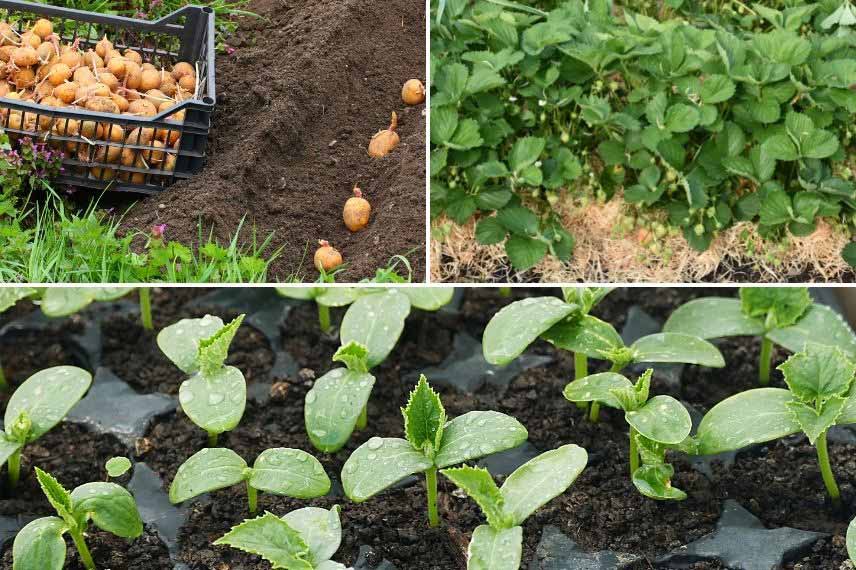
Planting potatoes, cleaning strawberries, sowing… it’s in April that everything comes together for a productive vegetable garden
→ Discover our April Vegetable Garden Calendar and learn everything you need to know about thethinning of sowings
Lawn and various works
The lawn and flowering fallows
- April marks the start of mowing. Remember to service your mower. For eco-conscious gardeners (and those looking to save money), let areas of flowering meadows grow and only mow the paths.
- Mix the first mowings into the compost or use them as mulch around trees and bushes.
- Sow flowering fallows: ladybird meadow or butterfly, slope mix or dry soil mix, the options are vast and you will surely find one that suits you.
- Sow the lawn directly in place in well-prepared, fine and raked soil, and of course free from weeds. Roll the area to ensure the seeds adhere well to the soil and water regularly with a fine spray to keep the soil slightly moist until germination if it doesn’t rain.
→ Learn more in How to care for your lawn in spring?
In the ornamental garden
- Take advantage of the nice days to garden with children and let them do their own sowing and planting.
- Weed the flower beds and paths.
In the pond
- Renew a third of the water volume in your pond: this will reduce waste concentration and encourage the awakening of plants and fish.
- Regularly remove filamentous algae that develop with the warming weather.
- With the warming weather, life resumes and it will be time to restart the filtration system. Beforehand, clean it and check that it is functioning properly.
- Protect the spawn of frogs and toads, and encourage the establishment of newts by leaving dead leaves, branches, and other plant debris in a small radius around your pond. And of course, ban any use of pesticides!
→ Gwenaëlle tells you all about maintaining a garden pond in spring.
And everything else…
- Order beneficial insects: lacewing larvae can be released preventively on low plants when aphid populations are not yet very developed. For taller plants (bushes, shrubs, trees, hedges), it is preferable to use ladybirds Coccifly (active as soon as the temperature reaches 15°C) or Coccilaure (active as soon as the temperature reaches 12°C). Also consider nematodes against white grubs, larvae of beetles and other pests that attack the roots of many ornamental crops, strawberries, and lawns.
- Give your garden furniture a facelift: brush the wood and apply a protective oil. Iron elements will regain their former glory after sanding and applying anti-rust varnish.
 Order your garden auxiliaries and further promote biodiversity. Give your outdoor furniture a facelift and enjoy the sunshine to introduce children to gardening.
Order your garden auxiliaries and further promote biodiversity. Give your outdoor furniture a facelift and enjoy the sunshine to introduce children to gardening.
- Subscribe!
- Contents
































Comments